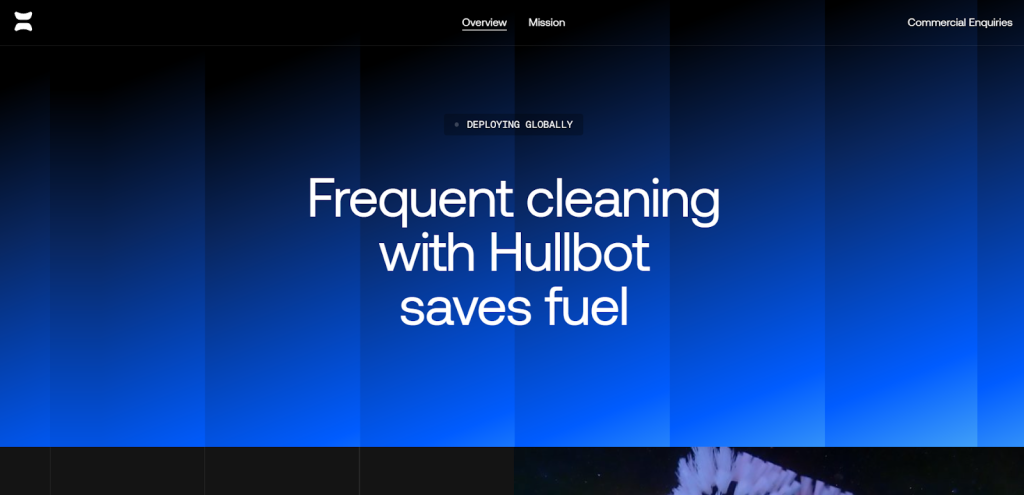Hullbot Raises $16M Series A to Revolutionize Proactive Hull Cleaning with Autonomous Ocean Robotics
November 9, 2025
byFenoms Start-Up Research

Hullbot, an ocean robotics startup redefining underwater hull cleaning, has raised $16 million in Series A funding to expand its fleet of autonomous robots and accelerate the global rollout of its proactive hull-grooming service. The round included investors such as Regeneration.VC, Katapult Ocean, Climate Tech Partners, Folklore Ventures, Trinity Ventures, and others - signaling strong confidence in Hullbot’s mission to decarbonize maritime operations through continuous, intelligent cleaning.
Founded by Tom Loefler, Hullbot has engineered a robotic system capable of cleaning a ship’s hull while it remains in the water - no dry-docking, no toxic chemicals, no downtime. This gentle yet highly precise approach prevents the buildup of biofouling - marine growth that increases drag, reduces speed, and can inflate a vessel’s fuel consumption by up to 40%.
By maintaining clean hulls consistently, Hullbot not only improves fuel efficiency and extends coating life but also reduces greenhouse-gas emissions for commercial fleets - a direct contribution to the global decarbonization of shipping.
The New Standard for Proactive Hull Care
Traditional underwater cleaning is reactive and infrequent - often a messy, high-cost affair that risks damaging coatings. Hullbot flips that logic: instead of waiting for fouling to accumulate, its robots perform light, frequent, automated cleaning sessions that keep surfaces smooth year-round.
Each robot uses adaptive navigation, soft brushes safe for modern silicone coatings, and high-precision control systems that allow it to operate efficiently in varying conditions. The service is designed around fleet schedules - operating autonomously in ports and marinas, cleaning quietly while vessels are berthed or idle.
This operational model allows ship owners to avoid costly maintenance windows while maintaining peak hydrodynamic performance - a simple but transformative shift.
Where the True Value Lies - and What Founders Can Learn
As Hullbot scales, an unexpected pattern is emerging: its greatest innovation might not be the robot itself but the service model wrapped around it.
The company didn’t just design a machine; it built an entire logistics and data ecosystem that makes proactive cleaning a recurring service rather than a one-off sale. This is where founders should pause and take note - because Hullbot’s model hides a masterclass in turning complexity into defensibility.
The insight is subtle but powerful: don’t sell your technology - operationalize it.
Instead of pushing units, Hullbot created a system that integrates scheduling, compliance, insurance, and performance analytics into one frictionless experience. That’s what turns a product into infrastructure.
Here’s why this matters:
Startups in hardware, robotics, or climate tech often struggle to monetize consistently because they stop at the point of invention. Hullbot went further - it embedded its technology into a workflow its customers already needed solved. Ship operators don’t want robots; they want guaranteed clean hulls, validated data for compliance, and predictable costs. By designing for the job-to-be-done, Hullbot created a service with recurring revenue baked in.
And the deeper takeaway for founders?
Operational complexity can be your moat. Most competitors avoid it. They focus on the tech demo, not the boring, repetitive service layer that scales revenue. Hullbot leaned into that hard problem - scheduling underwater operations across ports, handling local environmental rules, ensuring warranty-safe cleaning - and made it the reason they can’t be easily copied.
That’s the kind of insight that separates tech experiments from enduring businesses: Build your company around recurring proof of value, not one-time wow moments. The robot gets the press. The process wins the market.
Turning Data into an Asset
Every Hullbot operation captures detailed telemetry - hull condition, cleaning frequency, and drag impact - forming a growing dataset on how biofouling evolves across climates, coatings, and vessel types. Over time, that dataset becomes a new kind of asset intelligence, giving operators predictive insights on maintenance timing and coating performance.
This continuous-data model also strengthens customer stickiness. Once operators integrate Hullbot’s cleaning logs and inspection analytics into their workflow, switching providers becomes difficult - a classic data-driven moat built through routine operations rather than proprietary algorithms alone.
Environmental and Economic Payoff
Biofouling isn’t just a maintenance nuisance; it’s a climate liability. According to the IMO, global shipping accounts for nearly 3% of greenhouse-gas emissions, much of it worsened by drag from fouling. Frequent, light cleaning reduces that drag and thus fuel consumption - producing an outsized emissions benefit without retrofitting vessels or changing fuels.
By offering a sustainable, non-toxic, in-water solution that works with any hull coating, Hullbot enables fleets to hit both sustainability and cost-efficiency targets. The service aligns with new environmental regulations and carbon-accounting standards that reward measurable emissions reductions.
The Next Wave for Hullbot
With $16 million in fresh funding, Hullbot is expanding its fleet, scaling operations across new ports, and investing in software for global fleet coordination. The goal is to make proactive cleaning as routine as refueling - an always-on layer of ocean maintenance that keeps ships optimized every day they’re in the water.
As the shipping industry faces pressure to decarbonize, Hullbot’s combination of automation, sustainability, and operational intelligence positions it as a vital player in the blue-tech economy.
The next few years will determine whether proactive maintenance becomes the new normal - and whether Hullbot can prove that service innovation is as powerful as hardware invention in solving climate-scale problems.









